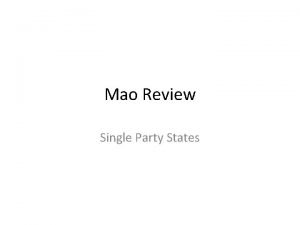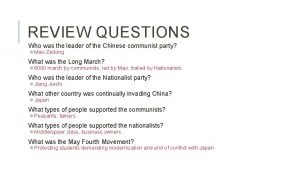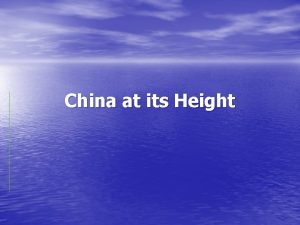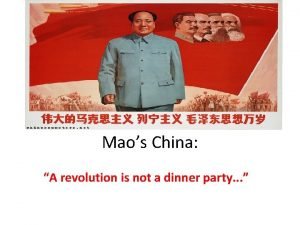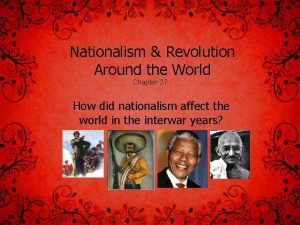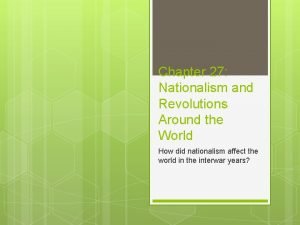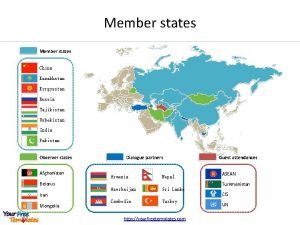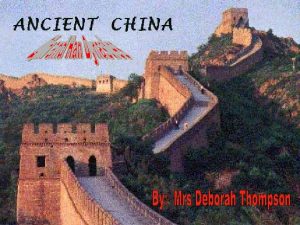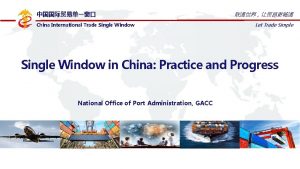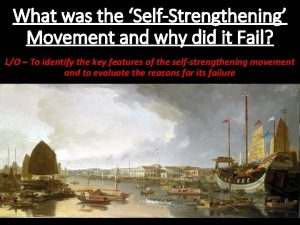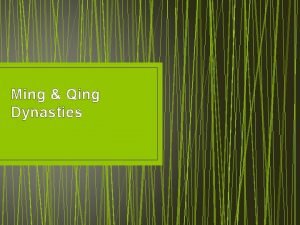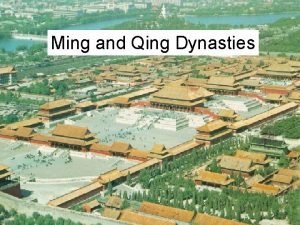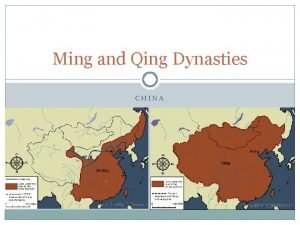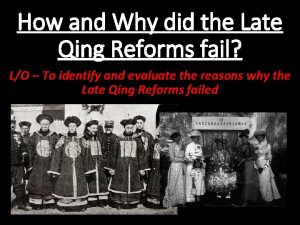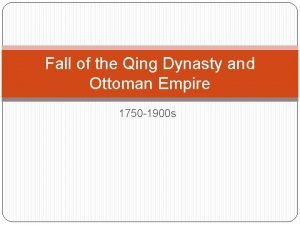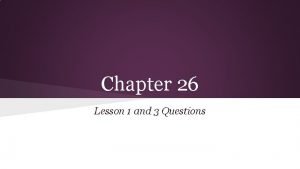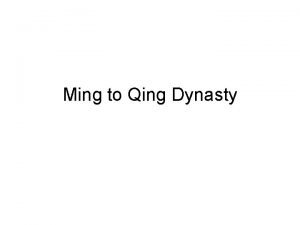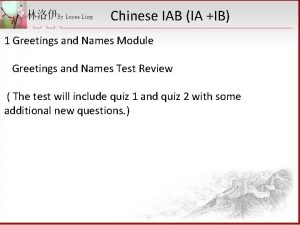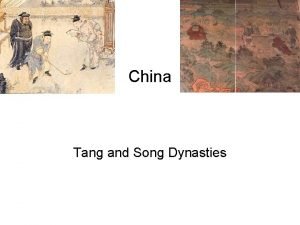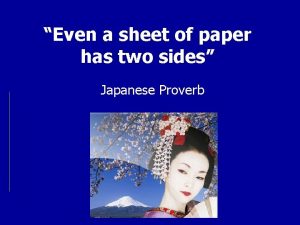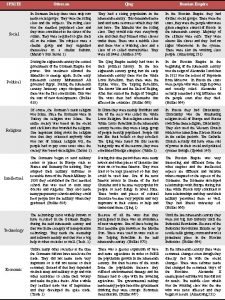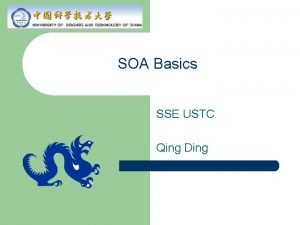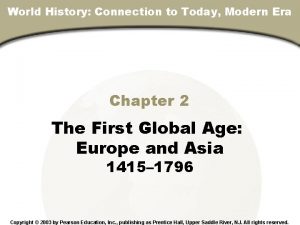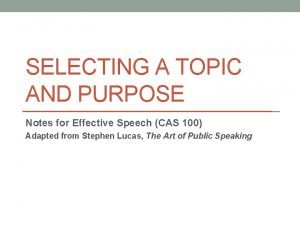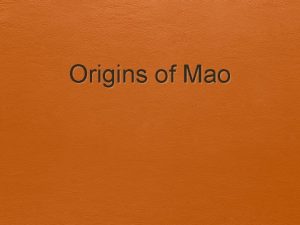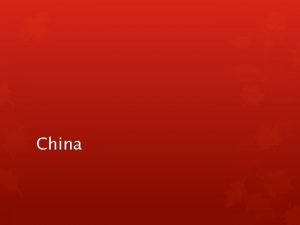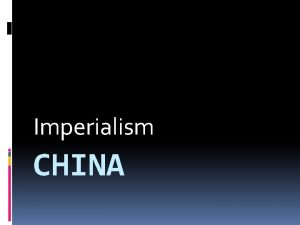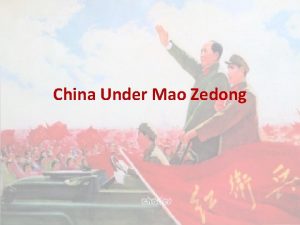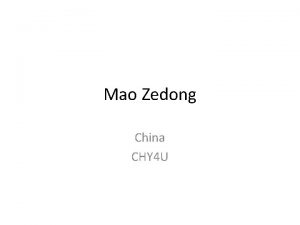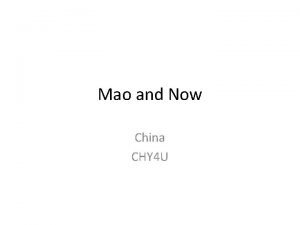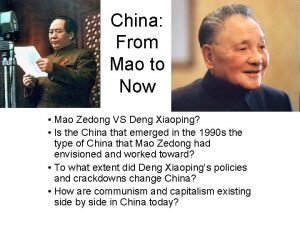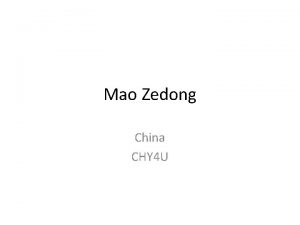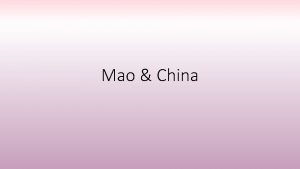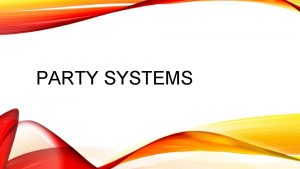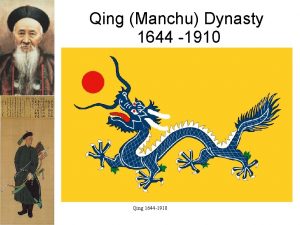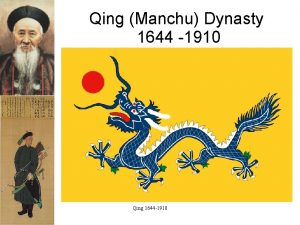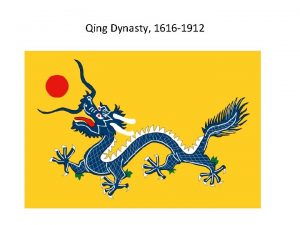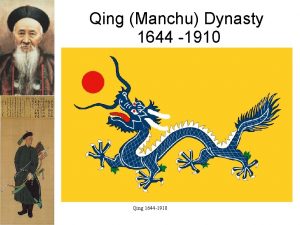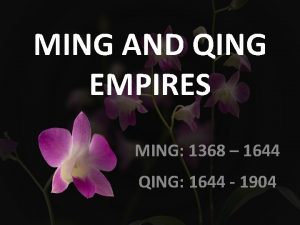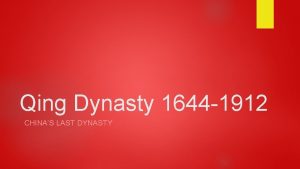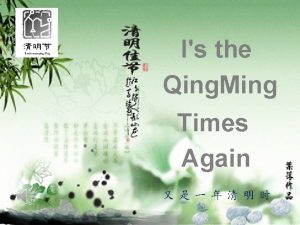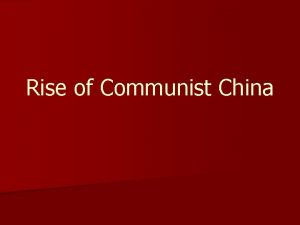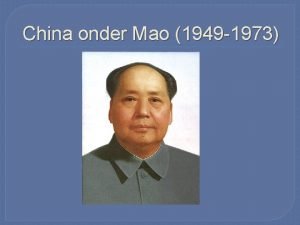Mao Review Single Party States China PreMao Qing

































- Slides: 33

Mao Review Single Party States

China Pre-Mao • Qing Dynasty – Economically controlled by British following Opium Wars – Resentment of foreign domination led to failed Boxer Rebellion 1900 – Primarily agricultural with subsistence farming • Revolution of 1911 – End of Quing Dynasty (Manchu control) – Rise of Sun Yat-Sen- advocated Nationalism and improvement of livelihood through socialism – 1912 formation of Nationalist Party- Guomindang (GMD) • World War I- former German colonies given to Japan • 1925 death of Sun Yat Sen led to Chiang Kai-Shek (Jiang Jieshi) – Targeted Communists unlike Sun Yat Sen • Japanese “disease of skin” • Communist “disease of the heart” – Aided by western powers like USA to keep communism out of China – By 1928 Chiang Kai-Shek had taken control of warlords • Stabilized currency and industrial growth • Japanese still in Manchuria

Mao leads the Communists • Russian Comintern est in 1919 in order to spread communism – encouraged formation of Communist party (CCP) – Encouraged Chinese communists to join the GMD to expel imperialists (western Europeans) from China • Chiang Kai Shek expelled Communists in 1927 -Mao created own brand of Communist in the countryside – Unlike Russia-Mao believed in the agricultural peasant – Built Red Army • well disciplined and reliable pay • Lacked funds for weapons so relied on guerilla warfare – Ordered land redistribution- poorer peasants encouraged to kill richer neighbors and landlords – 1930 ordered 2000 Red Army officers executed for staging revolt – Long March— 1934— 5000 of original 100, 000 communists survived the 8000 mile march – Surviving communists settled in Yan’an Soviet and Mao consolidated his base

Civil War in China 1946 • During Japanese invasion of WWII GMD and Communists join forces – GMD accused post war of being in league with USA and allies while Mao claimed to be only true Chinese patriots • Post WWII – USA aided Chiang Kai-Shek – But neither USA nor USSR wanted Civil War in China- USA negotiated ceasefire which GMD violated USA withdrew

Why did Mao become ruler of China in 1949?

Origins of Maoist ideology • Studied under Yang Changi who rejected Chinese, Confucian past • Studied western philosophers and decided solution to China’s future was a military one • Studied Marxism but believed the peasants were the future of China • Encouraged: – Voluntaryism- • individuals willingness to accept and share the same beliefs as those of the community • examples: renouncing past evil, re-education and remaking in the communist image – mass mobilization- everyone working together to decide on and carry out policies – self criticism

Elements of Mao Zedong Thought • Marxist Revolution-class struggle in which landowners and bourgeoisie had to be overthrown – Collective ownership of the means of production – Promote worldwide communist revolution • • Importance of peasants Two state revolution – – • Mass mobilization and voluntaryism – – • Stage 1 - private ownership continues Stage 2 - collectivization and nationalization of property and economic resources and remove remaining elements of bourgeoisie Party should learn from the people Campaigns should be people’s campaigns & people support voluntarily Continuous Revolution-constant process of renewal, to avoid corruption and complacency

Elements of Mao Zedong Thought • Self-criticism and rectification – – – • Ruthless determination – – • Prevent officials from becoming self satisfied and elitist Regular purges of the party to keep it pure Only through self-criticism would individuals see the wisdom of the mass campaigns and rectify false thoughts Will power and determination sufficient to bring about change provided everyone has total commitment Violence a necessary element of the revolution Primacy of Mao Zedong Thought – – Mao always right People could find solution to any problem if they studied Mao’s though sufficiently – Little Red Book

While Mao successfully took power utilizing his ideology maintenance of power proved more difficult • Mao clashed with other leaders- • esp Liu Shaoqi who wanted more planning and development of specialist skills • Deng Xiaoping – Believed the peasant massess, if they just were committed enough could make up for lack of technology and capital – yet it was not enough as evidenced by Great Leap Forward – China lacked experts, and wasted natural and human resources during his mismanagement. Great Leap Forward – Would not believe the evidence of the famine • Mao believed in self criticism for all but himself

While Mao successfully took power utilizing his ideology maintenance of power proved more difficult – 1959 Stepped down from Chairman of PRC but returned 1966 when he believed China returning to elitism • Return heralded rectification of communist thought • Remold the souls of Chinese through need of ruthlessness and violence to cleanse the state—Cultural Revolution—effect turmoil and destruction of his people

Mao established power 1949 -54 • Temporary Constitution of 1949 – Multi party system of those who had opposed the GMD but dominated by Communists – Some excluded from suffrage-country landlords, big business & prominent anti. GMD – Bourgeoisie did have right to vote to use their expertise – China divided into six regions all under the military – Most bureaucrats under GMD retained-but gradually removed with communists • Constitution of 1954 – – Single party state-communist party led by Mao-made decisions of state Party administration mirrored state administration If bureaucrats not communists then aided by one—but most communists Everyone required to meet regularly to hear about and comment on policies

Mao established power 1949 -54 • Living standards improved – Crime lowered – Job security – Public health— • water and sanitation improved • Prevention of diseases taught in city and countryside • Health officials trained—though doctors replaced with those trained in six months to give just basic services

Mao established power 1949 -54 • 1. 2. 3. 4. Mass Mobilization Campaigns- – While bourgeoisie kept to maintain their expertise, self criticism and rectification campaigns were used to stamp out individualism – Encouraged to inform on others – By 1951 6500 intellectuals made to study communism and artists who did not follow were imprisoned – Landlords denounced by peasants and removed after struggle sessions-2 millions landlords died often beaten by peasants Resist America and aid Korea campaign, 1950 – Suspicion of foreigners and arrested esp missionaries – Christian churches closed – By end of year, China closed to all foreigners except Russians Suppression of counter-revolutionaries campaign, 1950 -51 – Links to GMD, criminal gangs and religious sects – Denunciations and public executions Three antis campaign, 1951 – Against waste, corruption and obstruction – Struggle sessions, humiliation and group pressure to bring into line Five Antis Campaign 1952 – Against bribery, tax evasion, theft of state property, cheating and economic espionage – Workers encouraged to investigate employers-forcing employers into self criticism and thought reform – Many committed suicide due to humiliation

Purges of leading officials, 1954 • Following debate of 5 Year Plans for industry – Gao Gang- had backed Mao against Liu Shaoqi – Rao Shushi- supported Gao Gang to replace Zhou Enlai as vice chairman of CCP – Mao accused both of underground activities • Gao Gang committed suicide • Rao Shushi imprisoned until death in 1974

Mao’s maintenance of power from 1954 -1976 • By 1953– production had increased – Communist party membership increased so no longer needed previous bureaucrats – One party state established in Constitution • Mao felt it was time for state 2 of the revolution– full communism – Mao felt he was criticized and continued to consolidate power

100 Flowers Campaign, 1956 -57 • Mao lifted censorship and encouraged open criticism • Letters, articles, posters, rallies, Democratic Wall complained of political corruption, Russian influence, low living standards, censorship, privileged party members • Mao claimed beyond healthy criticism and reinstated censorship – List of critics? – Misjudge criticism? • Followed by crackdown on intellectuals---Anti Rightist campaign, 1957 – 500, 000 send to labor camps, country re-education, or executions

Mao disappears from public life • 1959 when Great Leap Forward a huge failure – Though stepped down from PRC chairman still had power – Purged Peng Dehuai who had criticized Great Leap Forward and split with USSR • Mao concerned by Liu Shaoqi and Deng Xiaoping but would not return to power until 1966 and launch of Cultural Revolution

Control during Cultural Revolution 1966 -76 • Another purge of Mao’s rivals – Red Guards mobilized to • attack the Four Olds: thought, culture, practices, and customs • Remove bad elements among the party, teachers, intellectuals and former bourgeoisie – Mao purged his rivals and retook complete control • May 1966 -purged the Group of Five- supporters of Deng Xiaoping and Liu Shaoqi • 1976 Replaced with Gang of Four who included Mao’s wife Jiang Qing • Launched the criticize Deng and oppose the rehabilitation of right-leaning elements campaign – Replaced Deng as prime minister – Deng demoted but saved by Mao’s death in 1976

Main influences on economic policy in Mao’s China • Goals – Collective ownership of production • Nationalization of industry • Collective farming – Desire to make China a world power • Surpass USSR • End foreign dependence – Immediate need for recovery after the damage caused by war • Implementation – Increase industrial investment • Reduce foreign imports • boost exports especially agriculture – Rather than new technology, relied on shear manpower

Agriculture & Land Reform, 1950 • Mao wanted peasants to lead the reform – Party stirred up peasants in speak bitterness campaigns- “dig the bitter root, vomit the better waters” – Encouraged peasants to turn on landlords • many executed on the spot – estimated 2 million killed – Party policy to select at least one landlord in each village for public execution • or held trial in which landlords lost their civil rights, land, household goods which were redistributed to the peasants – Ownership of land remained private but plots too small for efficient farming • • Party encouraged cooperative farming, but not required By 1952 grain production up 10% from 1936 By 1953, 40% of peasants farming cooperatively But larger landowners started buying up land consolidating farms – By 1955, Mao encouraged Agricultural Producing cooperatives (APCs)-rich peasants excluded from profits, could not get bank loans or buy seed • By 1956 most villages formed collectives and by 1957 90% of families in APC • state only purchaser of grain • CCP had greatest control of countryside in Chinese history—”modern serfdom under party control” J K Fairbank


Agriculture & Great Leap Forward, 1958 • Though production increased 5% in 1957, Mao thought consolidation of APC’s into larger communes was necessary – Like a small city of homes, hospital, schools – No private possessions, slept in unisex dormitories, communal teams dealt with cleaning & food preparation • Great Leap Forward 1958 – 70, 000 communes – No more private farming—everything directed party – Series of Maoist popular campaigns like Four Pests campaign which outlawed flies, mosquitoes, rats and sparrows

Effect of Great Leap Forward • Peasants lacked knowledge to farm on large scale • Peasants turn to industry and neglect agriculture • Some, following propaganda that grain production was a huge success, left the fields

Mao and Industry • Phase 1 - Soviet Model— 5 Year Plans 1953 -57 – All private industry and businesses nationalized • But managers stated on and received bonuses – Heavy industry (iron, steel, energy), transportation, communication prioritized and decrease in consumer goods • New RR across Gobi desert to get to oil, coal and iron deposits • Roads built • Manchuria industrialized, recondition former Japanese factories & mines – Soviet loans and money gained from low prices to peasants for grain-produced money for investment – Results-officially, overall targets exceeded 20% • Heavy industry tripled • First time China produced its own cars, tractors, airplanes, cargo ships, machine tools, penicillin • Population grew from 57 million (1949) to 100 million (1957)

Mao & Industry • Phase 2 - Great Leap Forward, 1958 – Leave Soviet model in favor of mass campaign combining agriculture and industry to rival USA and USSR • • Independence from USSR Chinese take responsibility for future-willpower Speed the pace of industrialization Make up for failed “ 100 Flowers Campaign” China “walk on two legs” agriculture & industry Class distinctions rising and Mao wanted to reassert equality Continuous revolution- do away with increasing bureaucracy and influence of central planning ministry

Mao & Industry- Great Leap Forward 1958 – Improvements in industry • Urban– – unrealizable goals too-target of 10. 7 million tons steel/ year 1959 to 60 million tons/year 1960 » Slogan “twenty years in a day” » Song “Produce more faster, better—Three years of bitter struggle! ---Ten thousand years of joy!” – party leaders in charge of factories – Everyone working-even kids during school day were made to produce bricks or concrete • State-owned Enterprises (SOE’s)- state controlled factories a lot like country communes—no more profits/bonuses to managers • By 1958 90 million peasants producing steel in backyard furnaces – Collected metals including pots, pans, tools, bicycles to melt – 99% of metal produce unusable

Great Leap Forward—Successful? – Industry • Huge increase in production • 99% of steel produced unusable • no more bonuses left little incentive to produce more • USSR thought unwise and withdrew technical support – Agriculture • 1957 gov took 17% of grain, 1959 took 28% but prices remain low so many farmers switch to industry • Worst drought in of 20 th century in northern & central China combined with flooding in south produced famine – Between 1959 -61, 20 -50 million died » ¼ to 1/5 of Tibetans died » Urban dwellers lived on 1200 calories/day (compared to 1300 -1700 calories/day at Auschwitz) – Mao did not acknowledge famine – Mao resigned from head of state leaving Liu Shaoqi and Deng Xiaoping in to deal with crisis

Great Leap Forward-aftermath • Imported grain from Australia & Canada • Reset different wages for skilled & unskilled workers-paid based on output • Backyard furnaces abandoned • Sent urban workers back to countryside – By 1961 -reorganized communes—smaller, less regimented (no more unisex dorms) – Family lands/operated lands returned • Five years to recoup from Great Leap Forward Cultural Revolution— did not officially change economic policy—chaos affected output – RRs used to move Red Guards left shortage for goods – Higher educated engineers and managers criticized by Red Guards – 1967 14% decline in production

Women in Maoist China • Equality of men and women– “Women hold up half the sky” –Mao • 1950 – Female infanticide ended, footbinding outlawed, girls go to work and school – 1950 Marriage Law forbid arranged marriages, payment of dowries and concubinage – Divorce permissible by either part –those in arranged marriages could sue for divorce • 1953 Election law gave women right to vote, encouraged to train for jobs traditionally held by men • 1958—communes-women freed from many domestic duties since unisex dormitories, towns had nurseries so could work outside the home

Effect on Women • Huge increase in number of divorces • Women still took care of children and worked • In Muslim areas, arranged marriages continued (in USSR- retaliation against women post Stalin’s reforms for women) • Still only made up 13% of party between 1954 -1975 • Mao worked against family unit – Schools taught love for Mao more important for family – Four Olds Campaign 1966 children encouraged to speak/inform on parents – Many youth sent far from home for rural work

Education • • 1949 - only 10% could read, 20% went to primary school, 1% secondary school Post 1949– – set up schools except for “black categories” (Those same who could not vote in original government) Little Teacher Program where children taught adult peasants By 1964 -Simplified Chinese characters to make easier Secondary school expanded, • aided by teachers and textbooks from USSR, scholarships to soviet universities • Post Sino-Soviet split—Chinese textbooks stripped of foreign influences and kids only studied Maoist ideology • Emphasized practical learning • Results: – Literacy to 70% by 1976 – By 1957 most villages had some sort of school, and secondary schools tripled – By 1976, 96% of children aged 7 -16 in school • However: – Education neither compulsory nor free – Quality varied by town – Emphasis on practical, anti-intellectualism, and political nature of advancement to better schools held back many Chinese – Children of Party leaders received best education – Schools centers for Maoist indoctrination, encouraging cult of leader – During Cultural Revolution, most schools closed

Relationship between church and state • • Communists believed churches were capitalist invention used to keep lower classes in check. Mao called church “poison” Confucianism, Buddhism, Islam and Christianity equally condemned – Closed churches – Expelled missionaries • Religious toleration guaranteed by the Constitution, but state defined “religion” and “superstition” differently-campaign against “superstition” began 1950 – Ancestor worship condemned along with traditional religious rituals – Could become patriotic churches and operate under government control • Clergy had to profess support of communism • No foreign allegiance • Allow government to ok appointments • During Cultural Revolution religion denounced as one of the “four olds” – – • No public worship or ceremonies Clergy rounded up and imprisoned Temples, churches, shrines destroyed Confucianism denounced as worst part of Chinese history 1950 Tibet captured--Targeted Tibetan culture – Forced to grow wheat and maize which was not edible, changed herding of yak which depleted milk and production – Caused famine killing ¼ of Tibetan population – Yet-Tibetan continued to reject Mao

Arts and Culture • Replace traditional with communist culture which embraced the common man • Art functioned as means to educate the masses • Following 100 Flowers Campaign 1956 -57, repression in Anti-rightist campaign • Persecution at height during Cultural Revolution 1966 -76 – Jiang Qing- (Mao’s wife and part of Gang of Four) censorship at height when she was “cultural purifier of the nation” – Foreign literature punishable – Libraries and museums closed – For two years only Mao’s Red Book was published
 Qing qing ting lyrics
Qing qing ting lyrics Premao
Premao Mao mao
Mao mao Qing china at its height
Qing china at its height Qing empire at its height
Qing empire at its height Mao revolution is not a dinner party
Mao revolution is not a dinner party When did mao take over china
When did mao take over china When did mao take over china
When did mao take over china Third party vs fourth party
Third party vs fourth party China warring states period
China warring states period Tajikistan india
Tajikistan india How did qin shihuangdi unite the states of northern china?
How did qin shihuangdi unite the states of northern china? Singlewindow.cn
Singlewindow.cn 11 free states
11 free states Northern and southern states
Northern and southern states Tyranny
Tyranny Conferência de berlim self-strengthening movement
Conferência de berlim self-strengthening movement Qing dynasty location
Qing dynasty location Qing conquest of the ming
Qing conquest of the ming Ming empire
Ming empire Qing conquest of the ming
Qing conquest of the ming Late qing reform
Late qing reform The rise and fall of qing dynasty
The rise and fall of qing dynasty Ming dynasty social
Ming dynasty social Decline of qing dynasty
Decline of qing dynasty Chapter 26 lesson 1 the decline of the qing dynasty
Chapter 26 lesson 1 the decline of the qing dynasty Qing dynasty dbq
Qing dynasty dbq Qing wen nin gui xing
Qing wen nin gui xing Venn diagram of tang and song dynasties
Venn diagram of tang and song dynasties Dang ju zhe mi
Dang ju zhe mi Qing dynasty social classes
Qing dynasty social classes Soa basics
Soa basics What policy did the qing adopt regarding foreign trade?
What policy did the qing adopt regarding foreign trade? The specific purpose of a speech states precisely
The specific purpose of a speech states precisely

